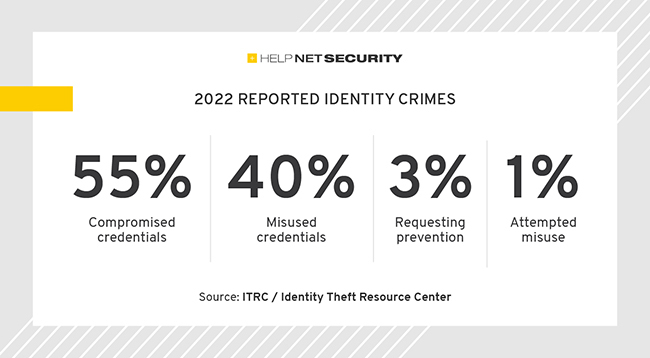Identity crimes: Too many victims, limited resources
The Identity Theft Resource Center (ITRC) has documented incidents of identity theft reported during 2022 and the first quarter of 2023, highlighting the use of strategies by criminals to convince people to willingly share protected information.
The number of reported identity crimes in 2022 was nearly the same as the all-time high in 2021, with only a slight decline of less than 1% to 14,817 cases.

Identity crimes in 2022
- 55% (8,199) of identity crime cases were related to compromised credentials, 40% (5,961) reported cases were due to misuse of credentials, and 1% (220) of reported cases were due to victims being notified about attempted but unsuccessful misuse of their credentials.
- Identity misuse was primarily due to account takeover or new account creation in 2022. 46% of non-governmental and non-financial accounts were misused, with social media accounts making up 72% of non- governmental/financial account abuse.
- Most reported identity misuse was due to existing account takeover (61% – 3,637 victims). Second to existing account takeover in 2022 was misuse related to new account creation (32% – 1,889 victims).
- In 2022, 80% of identity compromises involved using identity credentials as part of a scam, compared to 77% in the previous year. 61% (4,081) of people who contacted the ITRC about compromised identities were the victims of Google Voice scams.
“Our 2022 Trends in Identity Report highlights lots of changes in the identity crimes landscape,” said Eva Velasquez, President and CEO of the Identity Theft Resource Center.
“We have seen a lack of transparency in data breach notices grow, leaving us all more vulnerable to falling victim to an identity crime. Research shows that Black communities suffer more financial losses than the general population from identity crimes. However, one thing that has not changed is that there are too many victims of these crimes and too few resources to help them. The recent Presidential Planning Document released by the White House highlights the need for government agencies and nonprofits like the ITRC to work together to help victims who don’t know what to do next. We look forward to working with our nation’s leaders to bring the vision of improved services for identity crime victims to reality,” Velasquez continued.
Identity thieves trends
Identity thieves are improving social engineering techniques to convince people to share personal and business information. Attackers found success in pretending to be a new or existing personal relationship to takeover a victim’s friends’ social media account.
Thieves aren’t just collecting information through data compromises; they’re increasingly misusing data in new ways. While social media accounts were the primary type of account compromised in the past year, ~30% of existing account takeover and 62% of new account creation were reported as impacting financial accounts, primarily bank and credit card accounts.
Identity criminals are targeting Driver’s License accounts. In 2021, DMV accounts made up 4% of government accounts that were misused or taken over. The number increased to 15% in 2022.